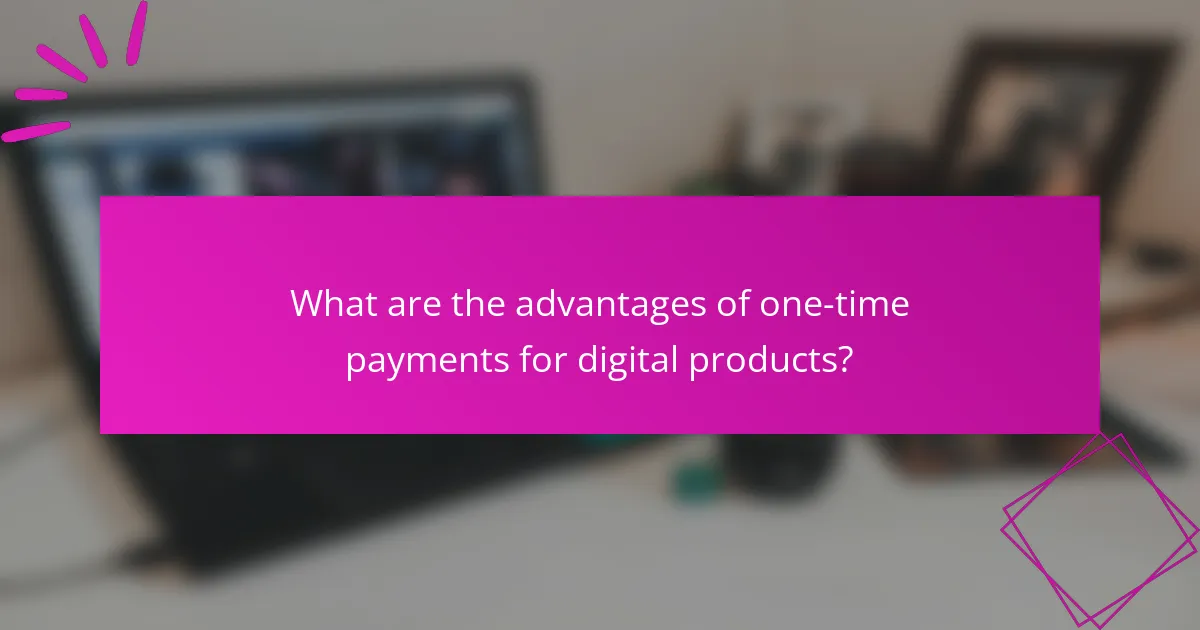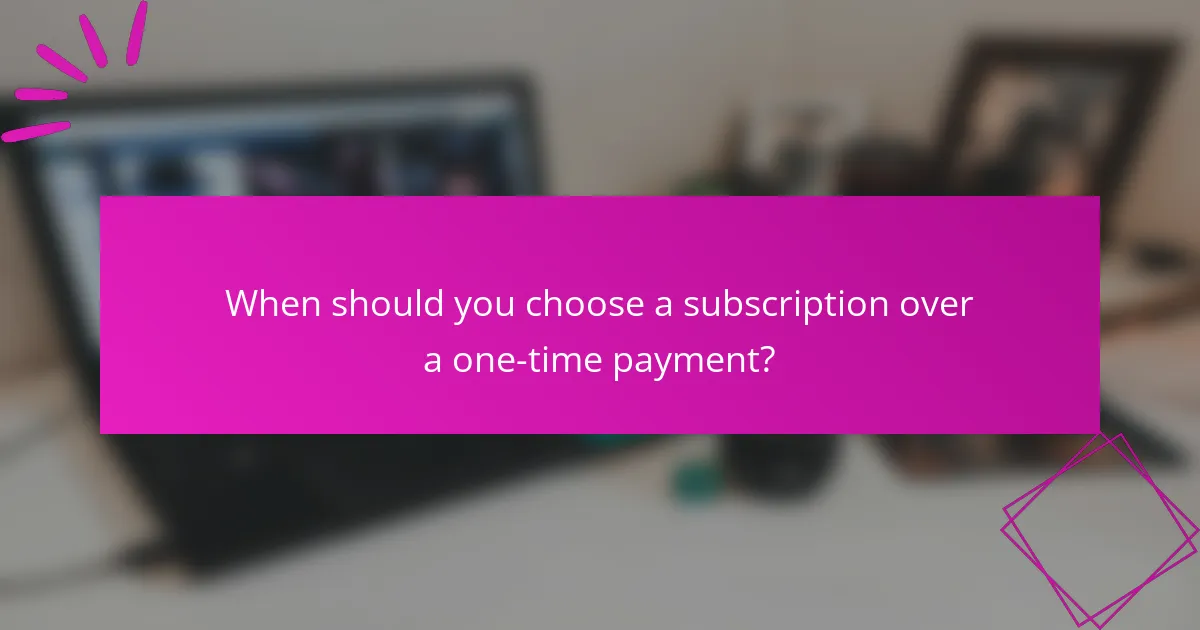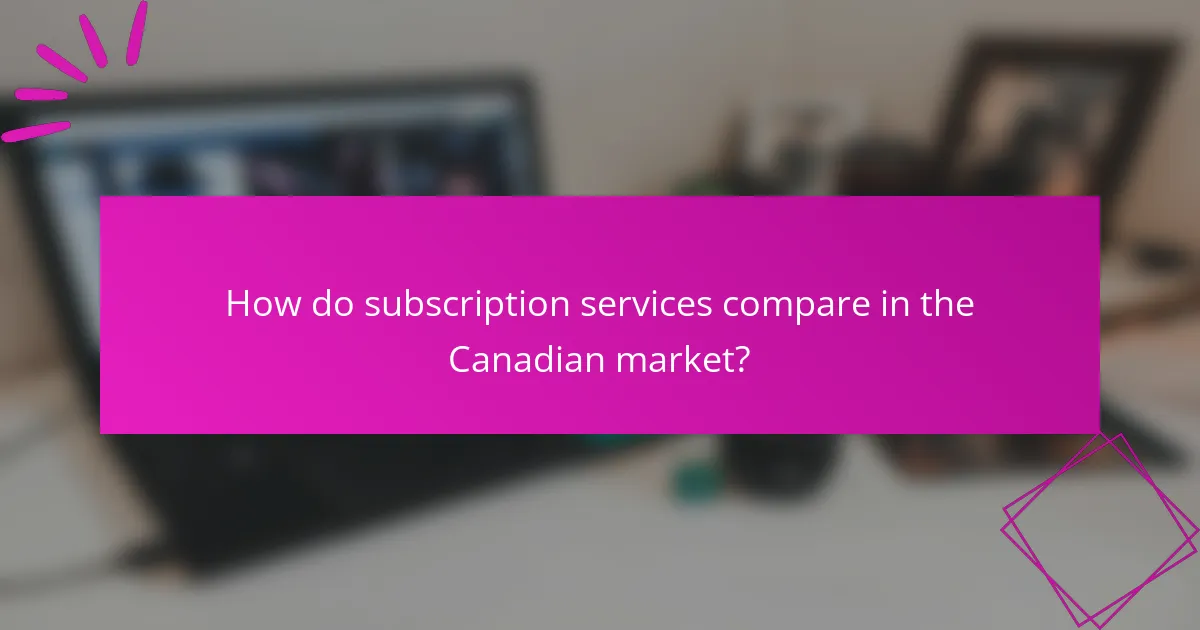When deciding between subscription models and one-time payments, it’s essential to consider the nature of the product or service and the customer’s needs. Subscriptions offer ongoing access and continuous value, fostering long-term relationships, while one-time payments provide immediate ownership and cost predictability. Understanding the advantages of each approach can help consumers and businesses make informed choices tailored to their specific situations.

What are the benefits of subscription models in Canada?
Subscription models in Canada offer businesses a steady income while providing customers with ongoing access to products or services. This approach can enhance customer relationships and streamline budgeting for both parties.
Consistent revenue stream
Subscription models create a reliable revenue stream, allowing businesses to forecast income more accurately. This consistency can be particularly beneficial for startups and small businesses, as it reduces financial uncertainty and helps with cash flow management.
For example, a software company charging CAD 20 per month can expect a predictable income of CAD 240 per year from each subscriber, making it easier to plan for expenses and growth.
Access to regular updates
With subscription services, customers often receive regular updates and improvements without needing to make additional purchases. This ensures that users always have access to the latest features and enhancements, keeping them engaged and satisfied.
For instance, a streaming service might regularly update its library with new content, ensuring subscribers always have fresh options to enjoy, which can enhance user experience and retention.
Lower upfront costs
Subscriptions typically involve lower upfront costs compared to one-time payments, making products and services more accessible. This can attract a broader customer base, especially for high-value items like software or premium memberships.
For example, instead of paying CAD 600 for a software license, a customer might pay CAD 50 per month, spreading the cost over time and making it easier to budget.
Enhanced customer loyalty
Subscription models can foster greater customer loyalty as users become accustomed to a service over time. This ongoing relationship can lead to increased satisfaction and a lower likelihood of switching to competitors.
Businesses can enhance loyalty by offering exclusive benefits to subscribers, such as discounts, early access to new products, or personalized content, which can further solidify the customer relationship.

What are the advantages of one-time payments for digital products?
One-time payments for digital products offer several distinct advantages, particularly in terms of ownership and cost predictability. Users can purchase a product outright without the burden of ongoing fees, making it an appealing option for many consumers.
Immediate ownership
With a one-time payment, users gain immediate ownership of the digital product. This means they can access and use the product without waiting for a subscription period to end or worrying about losing access if a payment fails. For example, purchasing software outright allows for uninterrupted use as long as the system requirements are met.
Immediate ownership also fosters a sense of investment in the product, encouraging users to explore its full potential without the pressure of recurring costs.
No ongoing fees
One-time payments eliminate the need for ongoing fees, which can accumulate over time with subscription models. This is particularly beneficial for users who may not use the product frequently or for an extended period. For instance, if someone only needs a photo editing tool for a specific project, paying once can be more economical than subscribing for several months.
By avoiding recurring charges, users can better manage their budgets and avoid unexpected expenses, making it easier to plan financial commitments.
Clear value proposition
The value proposition of one-time payments is straightforward: pay once and own the product indefinitely. This clarity can be appealing to consumers who prefer to know exactly what they are getting for their money. For example, a user might find it easier to justify a one-time purchase of an eBook compared to a subscription service that requires ongoing payments.
Additionally, this model often includes updates or support for a limited time, which can enhance the perceived value of the purchase.
Suitable for casual users
One-time payments are often ideal for casual users who may not need a product regularly. These users can make a single purchase without the commitment of a subscription, which can be especially attractive for those who only require a tool for occasional tasks. For example, a casual gamer might prefer to buy a game outright rather than subscribe to a gaming service.
This approach allows casual users to enjoy digital products without the pressure of ongoing costs, making it a practical choice for those with limited usage needs.

When should you choose a subscription over a one-time payment?
Choosing a subscription over a one-time payment is ideal when you need ongoing access to services or products. Subscriptions provide continuous value, often with added benefits like updates and support, making them suitable for certain use cases.
For ongoing services
Subscriptions are best for services that require regular use, such as streaming platforms, software, or gym memberships. For example, a monthly subscription to a software tool ensures you always have access to the latest features without the need for additional purchases.
Consider your usage patterns; if you anticipate needing a service consistently over time, a subscription can offer convenience and potentially lower overall costs compared to multiple one-time payments.
When frequent updates are needed
If a product or service frequently evolves, a subscription model ensures you receive updates automatically. This is common in software, where developers release regular patches and new features that enhance functionality.
For instance, a subscription to a design tool allows users to benefit from the latest design trends and tools without having to buy a new version every year. This model keeps you current and competitive in fast-moving industries.
For budget management
Subscriptions can help with budget management by spreading costs over time, making them more predictable. Instead of a large upfront payment, you pay smaller amounts regularly, which can fit better into monthly budgets.
For example, paying $10 monthly for a service is often easier than paying $120 upfront. This approach can be particularly beneficial for individuals or businesses managing tight cash flows or planning expenses over the long term.

What factors influence the choice between subscription and one-time payment?
The choice between subscription and one-time payment depends on various factors, including the type of product, the target audience, and current market trends. Understanding these elements can help businesses and consumers make informed decisions that align with their needs and preferences.
Product type
The nature of the product significantly influences the payment model. For instance, software services, streaming platforms, and online courses often benefit from a subscription model, providing ongoing access and updates. In contrast, physical goods like electronics or furniture typically favor one-time payments, as customers prefer to own these items outright.
Consider the longevity and usage frequency of the product. Items that require regular updates or ongoing support are better suited for subscriptions, while those that serve a specific purpose or are used infrequently can be sold as one-time purchases.
Target audience
Understanding the target audience is crucial in determining the preferred payment method. Younger consumers, particularly millennials and Gen Z, often lean towards subscriptions for their flexibility and lower initial costs. Older generations may prefer one-time payments, valuing ownership and the absence of recurring charges.
Additionally, consider the financial habits of your audience. If they are budget-conscious, a subscription model may appeal due to its manageable monthly fees, while those with higher disposable income might opt for one-time purchases to avoid long-term commitments.
Market trends
Current market trends can heavily influence the decision between subscription and one-time payment. Many industries are shifting towards subscription models, as seen with the rise of subscription boxes and streaming services. This trend reflects a broader consumer preference for access over ownership.
Stay informed about competitors and industry standards. If similar products in your market are adopting subscriptions, it may be beneficial to follow suit. However, if your product stands out as a premium offering, a one-time payment model could reinforce its value.

How do subscription services compare in the Canadian market?
In Canada, subscription services are increasingly popular, offering consumers flexibility and convenience. They typically provide ongoing access to products or services for a recurring fee, which can be more economical for frequent users compared to one-time purchases.
Popular platforms
Several platforms dominate the Canadian subscription market, catering to various needs. Notable examples include Netflix for streaming, Spotify for music, and Adobe Creative Cloud for design software. Each platform offers unique features and pricing structures that appeal to different consumer segments.
For instance, Netflix offers tiered pricing based on streaming quality and the number of simultaneous users, while Spotify provides both ad-supported free access and premium subscriptions. This variety allows consumers to choose plans that best fit their usage patterns and budget.
When considering a subscription service, evaluate the frequency of use and the total cost over time. For example, if you watch several movies or listen to music daily, a subscription may save you money compared to purchasing individual titles or albums. Always compare the monthly fee against your expected usage to determine the best value.



